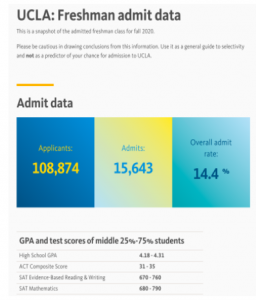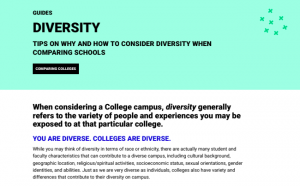
HS & First Year Students |
By: Breakthrough San Juan Capistrano and Let’s Go To College CA
Congratulations on considering applying to the University of California! Tens of thousands of students apply to the UCs each year (approximately 170,000 first-time freshmen applied last fall), so the UC admissions is definitely a large-scale process. Because so many applications are submitted, it can be difficult to adjust your application information after submission. Getting it right the first time will ensure that your applications are fully processed and that each school has the correct information on file for you from the start.
While many parts of the UC application are self-explanatory or provide clarifying instructions, some tend to trip up students. Something as simple as mistyping your date of birth or accidentally clicking that you are not a California resident can cause a headache down the line in order to correct this information. This guide is intended to share common mistakes that we see students make each year, so hopefully, you can avoid them when applying to the UCs.
The following “tips” are organized in the order that they appear on the application. You can follow along with this guide as you fill out your application, or use it to double-check your responses before you submit. If and when you have additional questions, don’t hesitate to contact your high school academic advisor or counselor, or UC Admissions at ucinfo@applyucsupport.net or (800) 207-1710.
About You: “Citizenship and Residency” Section
This section is used in a variety of ways, including determining California residency for tuition purposes. California residents have cheaper tuition than non-California residents, so you want to make sure that you complete this section accurately.
- Question: “What is your country of citizenship?”
- Tip: Undocumented and DACA students should select “No selection”. Without doing this, they may be marked as an international student, not a California resident.
About You: “Demographics” Section
- Question: “Which of the following groups best describes your racial background”
- Tip: Often, Latinx students ask about what to select here, as some students feel that the options do not reflect their identity. The demographic section is optional, so students do not have to mark a selection here if there is not one that they identify with.
The race and ethnicity categories on the UC application are connected to the categories used by the US Department of Education and the US Census, and may not directly reflect how a student self-identifies.
About You: “Your Household” Section
- Question: “What was the total income earned in 2022 by your parents or legal guardians?”
- Tip: If you don’t have access to your family’s taxes, or aren’t sure of the exact number here, you can use your best estimate. This number will be used to help calculate your eligibility for UC application fee waivers, but will not be used for financial aid (you will have to complete a FAFSA or CA Dream Act application to apply for financial aid).
If you have access to your parent/guardian’s 2022 taxes, you can use the “Total income” number, which is line 7b on the 2022 1040 tax form.
- Question: “How many people were supported by this income?”
- Tip: This question can be easily answered by finding the household size on the 2022 tax forms. To do that, add up the total number of people who filed the taxes (listed at the top of the 1040 form) as well as the total number of people listed as dependents. For example, if I come from a single-parent household, and my parent filed taxes and then claimed me and my 3 siblings as “dependents,” we would answer “5” to this question.
If you don’t have your tax forms, you can answer this question just by adding all of the people supported by the income you listed, including yourself. This number does not have to be the same as the number of people living in your home- you should not include people living with you who are not supported by your parent/guardian’s income.
About You: “Parent Information” Section
- Tip: You only have to include one parent/guardian/person who looks after you here. While you should include all parents/guardians that apply to you, if you live in a single-parent household, for example, you can complete this question with just one parent/guardian. If you are independent and do not have a parent/guardian, you can select “Other” and then describe who looks after you.
Campuses and Majors: “Choose Majors” Section
- Tip: Some UC campuses offer “alternate major” options, and like the application says, if you are not accepted into your first-choice major, you can be considered for your alternate major if you select one on your application. When choosing majors, it is important to consider “impaction,” which is when more qualified people apply than there are spaces available. Impacted majors can be more selective than non-impacted majors, and could mean that a “likely” school becomes more of a “target” or “reach” for you simply because the major you are applying to is more selective.
If you have questions about what major to choose, you should talk to your high school counselor, or you can call or email the UC admission office or major department to get more information. For example, if I was interested in nursing at UCLA, but am unsure whether to apply to the nursing major because it is impacted, I could talk to my counselor, the UCLA admissions office, or the UCLA nursing department.
Academic History Section
When you apply to the UC, your GPA is recalculated to include your A-G classes. It is important that you provide the correct information so that your GPA can be calculated correctly. We advise having a copy of your transcript available while you fill this out. If you have any questions about how to complete this section, you should contact your high school counselor or academic advisor.
- Question: “Add high school” or “Add college”
- Tip: When adding schools if your school does not appear with your first search, you can try different spellings or parts of the name. Sometimes this can help you find your school as it appears in the UC application system. Additionally, you can use the “school code” to help locate your school. This can be found by searching for “your school + school code” online. These codes are sometimes called “CEEB codes” or “college codes.”
- Question: “What is this school’s term system?”
- Tip: Sometimes this can be confusing for students, especially if you receive mid-term grades alongside final grades. If you are unsure of your school’s term system, you should check with your high school academic advisor or counselor.
- Question: “Enter courses & grades”
- Tip: During the course-entry sections, make sure that you type the courses exactly as they appear on your transcript. Additionally, use the “Honors Codes” and “Grades Codes” at the top right of each section to help you report your grades for each grading period.
For 11th grade, you will have options for “Credit (CR),” “No Credit (NC),” Pass (PS),” and “No Pass (NP)” to represent grades during the Spring. For courses that only meet for part of the year, you can put “NO” for the parts of the year when you did not have that course. For courses during the current grading period, you can put “IP” for “In Progress.” For future grading periods, you can put “PL” for “Planned.”
- Question: “California State Student ID”
- Tip: You can complete this section without adding this number. That said, you should be able to find it on your transcript, or can ask your high school counselor or academic advisor if you need help finding it.
- Question: “Additional comments”
- Tip: This section can help you add value to your application, especially if there is something important about your academic record that is not shared elsewhere. That said, you do not have to complete this question.
Some questions to consider when deciding whether to complete this section are: Were there any courses that I was unable to take for a reason out of my control (i.e. prevented by school policy or administrators, lack of transportation to a class after regular school hours, course not offered at your school, etc.)? Does my transcript accurately reflect my academic ability? Were their obstacles out of my control that negatively affected my academic performance?
Test Scores Section
- Question: “Do you want to report any ACT or SAT test scores?”
- Tip: Because of COVID-19 and a recent lawsuit, the UC campuses have adjusted their SAT/ACT testing requirements. All UC campuses other than UCSD, UCLA, and UC Merced will not consider SAT/ACT testing for admission. UCSD, UCLA, and UC Merced will be test-optional, so you can submit your scores if you choose, but it will not hurt you if you do not submit test scores.
Activities & Awards Section
- Question: “Add activities & awards”
- Tip: To fill out this section, we suggest that you start by considering how you spend your time, in and out of school. This can include formal activities like clubs, teams, work, volunteer experiences, etc. as well as more informal or self-directed activities, like caring for younger siblings, art or music, language self-study, etc. It can also be helpful to partner with a friend or family member to brainstorm activities/awards- they may be able to remind you of things you leave out.
When adding activities and awards, there may be some activities that can fit in multiple spaces. For example, if you are a Boys and Girls Club member, but also volunteer as a tutor for elementary school students at your Boys and Girls Club, this activity could fit as both an extracurricular activity and community service activity. It is okay to add activities like this in multiple categories, especially if it will give you the opportunity to provide a more in-depth description of your different roles.
Some students have trouble estimating their hours/week and weeks/year for their activities. It can be helpful to know the total number of weeks in your school year (often 36 weeks/year for schools with Monday-Friday school weeks in CA) as well as the total number of weeks in a year (52). If the hours of involvement vary throughout the year, we sometimes suggest calculating the hours spent during a busy week and those spent during a non-busy week and then averaging those to get a more accurate number for estimated hours/week.
Before you start adding descriptions, we HIGHLY encourage you to draft them in a separate document. Then, you can edit and finalize your descriptions there without worrying about whether they will be saved in the UC application (sometimes the application crashes, and that could mean a lot of lost work if you write directly in the application…). You can also reuse these descriptions in the future for other applications, like the Common App or scholarship applications.
Scholarships & Programs Section
- Question: “Support Programs”
Personal Insight Section
- Question: “Personal insight questions”
- Tip: When completing this section, know that all of the 8 personal insight prompts are considered equally- there is no “best” prompt to choose. The most important thing is to select prompts that allow you to share important aspects of yourself that add value to the other parts of your application (your transcript, activity list, etc.).
As with the activities and awards section, we highly recommend that you type these responses in a separate document first, and then copy and paste your final versions into your application.
- Question: “Additional comments”
- Tip: Often students aren’t quite sure how to use this section, or if they should use it at all. After completing the rest of your application, if you feel that it adequately represents who you are, then you may not need to add anything in this section. If instead, you feel that there is something about you and your story that has not been shared, the additional comments section is a great space to add that extra information.
Given the COVID-19 pandemic, this would be a great space to provide context to your COVID-19 experience, especially if you believe that it is relevant to your college application.
Review and Submit Section
- Application Fees
- Tip: If you qualify for fee waivers to pay for your application fees, these will be visible here. Students can only use up to 4 fee waivers, so even if you qualify for 4 UC fee waivers and also have 2 College Board fee waivers, you can only use 4 in total to pay for the UC applications.
If you do not qualify for UC fee waivers but you do have 2 College Board fee waivers, you can pay by mail, and can include your College Board fee waivers via mail, along with a check if you apply to more campuses. If you did not receive UC fee waivers but believe that you should be eligible for them, you can first check your household income section to make sure your information is correct, and can then apply for fee waivers using the instructions in the “Review and Submit” section. Typically, the fee waiver application can take 7-10 days to be processed by the UC.

By: Breakthrough San Juan Capistrano and Let’s Go To College CA
Source: https://admission.universityofcalifornia.edu/apply-now.html
Basic Needs Support, HS & First Year Students |
Now, that you’ve chosen your college your next step is planning! Will you be dorming on campus or live at home? What meal option will you choose? These are new and sometimes confusing choices to make. Sometimes, your financial aid may not cover these costs. Be sure you know how much this will all cost, so you know how to budget. Each campus has its own system with unique options and prices. Make sure you know before you go.

To learn more about housing and meal options when comparing schools, download this guide Housing and Meals Explained. Guide provided by DecidED

 The National Average Acceptance Rate is 66.1%. Acceptance Rate does not determine if the school is a fit for you or if you will be successful there.
The National Average Acceptance Rate is 66.1%. Acceptance Rate does not determine if the school is a fit for you or if you will be successful there. 







